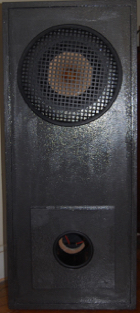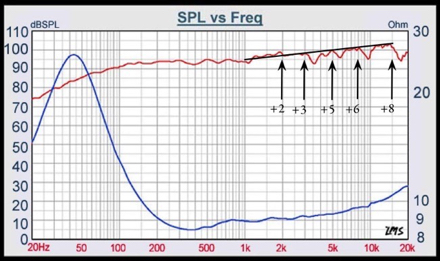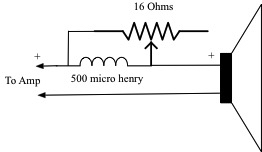Full Range Single Driver Speaker Project



Single driver speakers are very popular and have many advantages, primarily simplicity, ease of drive, and excellent performance. However, most single driver models require horn loading. There is nothing wrong with horn loading but the cabinets are difficult for the hobbyist to build. Bass reflex cabinets are much simpler to construct and consequently were selected for this project.
The driver used is the Tang Band W8-1772. It has an efficiency of 95 dB for one watt. All Transcendent Sound amps can easily drive this speaker.
Single driver speakers suffer from a response anomaly in the upper registers. They all have a steadily rising output with frequency and this speaker is no exception. Not taming the rising output will cause the top end to be very hot and peaky. An adjustable attenuation network has been developed to correct for the rising output.
Notice in the graph below, the output slopes up above 1000 Hz. At 2kHz it is +2 dB, +3 dB at 3kHz, +5dB at 5kHz, +6 dB at 8 kHz, and +8 dB at 15 kHz. The attenuator must level out the response to equalize the output.
Calculations show that a 500-microhenry (0.5 mH) inductor in parallel with an 8-ohm resistor should do the job. Using a 16-ohm, 50 watt L-pad set at mid-rotation provides 8 ohms and yet still allows for considerable range of adjustment. The inductor was glued to the back with 5-minute epoxy.
At center rotation, the network gives the following measured electrical response:
1 kHz: 0 dB
2 kHz: -1dB
3 kHz: -3 dB
4 kHz: -4 dB
6 KHz: -5.5 dB
8 kHz: -6 dB
10 kHz: -6.5 dB
20 kHz: -7 dB
This very closely matches the desired characteristic. At maximum attenuation, the following electrical response was measured.
1 kHz: 0 dB
2 kHz: -1 dB
3 kHz: -2 dB
4 kHz: -3.2 dB
6 kHz: -5.5 dB
8 kHz: -6.5 dB
10 kHz: -8.5 dB
20 kHz: -12 dB
The difference is primarily in the top octave. Setting the L-pad at minimum resistance effectively takes the network completely out. Use the left and center terminals of the L-pad as viewed from the rear. Do not follow the instructions that come with it. The inductor is an air core unit with 18 AWG wire
The cabinet volume is 3 cubic feet. External cabinet dimensions are 37.5 inches tall, by 15.5 inches wide, by 11.75 inches deep. The walls are 3/4 inch thick plywood and the vent centerline is 8 inches off of the bottom. The vent is 4 inches in diameter and 4 inches long and is shown mounted in a plate because it was reduced in size. The initial size was 6 inches in diameter and 2 inches long. This was too under damped and caused excessive boomy bass. The selected size over damps the speaker, which extends the bass to well below 50 Hz and removes the thumping. It also has the beneficial effect of cleaning up the midrange because of the reduced cone motion.
Damping was provided with 1.5 inch thick acoustic foam. Line the top, bottom, sides and top half of the back. No damping on the front panel. Damping is a personal taste issue so use what sounds best to you. Same goes for the setting of the L-pad.
The inexpensive 12 inch grill provided an unexpected benefit. It tends to act as a diffuser and break up high frequency beaming. This spreads out the sound stage and widens the “sweet spot”. It has to be oversized to give vertical clearance over the mounting ring. It was glued on with silicone.
The prototype was finished with an oil based “hammered” finish over oil an based primer. Latex products are much easier to work with but the oil based paints give a rock hard finish.
They sound fantastic! The bass is full and solid. Transients are crisp and sharp. Once they break in after about 100 hours, the sound greatly improves. They are very musical and natural sounding. After break-need, the attenuator can be reduced. Typically, start at the 12 o’clock position and end up at the 3 o’clock position after break-in. Final setting setting is a personal taste issue. Most importantly, they play extremely well with the 1.5 watt 300B amp and only cost $600 to build!
They aren’t perfect, no speaker is, but they get you very close for very little money.